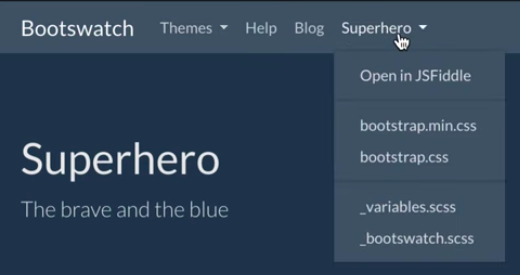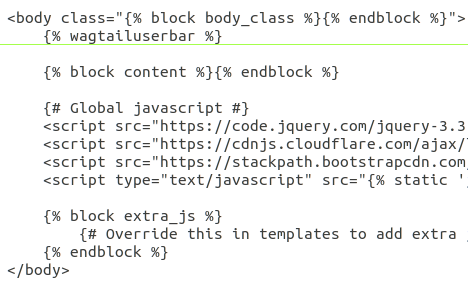[Django] 07 - Build a Simple Blog by Wagtail
传统方法
一、资源
-
namespace
Ref: 实战Django的URL命名空间namespace【多用户时可能会用到】
-
model.manager
Post.objects.all() --> 但本意是 只关心:published的条目,所以需要自定义(overwrite)。

改为如下:
[views.py]
def home(request): # newmanager自定义了filter all_posts = Post.newmanager.all() # all_posts 给模板的参数 return render(request, 'index.html', {'posts': all_posts})
object的默认定义,以及newmanager的自定义替代者的形式。
[models.py]
class NewManager(models.Manager): def get_queryset(self): return super().get_queryset() .filter(status='published') objects = models.Manager() # default manager newmanager = NewManager() # custom manager
-
urls
urlpatterns = [ path('admin/', admin.site.urls), path('blog/', include('blog.urls', namespace='blog')), # ----> ]
<key:value>
[blog.urls]
urlpatterns = [ path('', views.home, name='homepage'), path('<slug:post>/', views.post_single, name='post_single'), ]
查看数据库(model) 中是否有对应的数据。没有就返回默认的404页面。
[views.py]
def post_single(request, post): # 如果有,且还是published,就好;否则,自动返回内置的404页面。 post = get_object_or_404(Post, slug=post, status='published') # post 给模板的参数 return render(request, 'single.html', {'post': post})
-
reverse
{% for post in posts %} <div class="col-12"><h1> <a class="text-dark" href="{{post.get_absolute_url}}">{{post.title}}</a> </h1></div> <div class="col-12"><p>{{post.excerpt}}</p></div> {% endfor %}
Django reverse() 反转 url。
def get_absolute_url(self):
return reverse('blog:post_single', args=[self.slug])
Ref: Django URL重定向的3种方法详解
Ref: Django基础(10): URL重定向的HttpResponseDirect, redirect和reverse的用法详解【为主】
- [HttpResponseDirect方法]
- [redirect方法]
- [reverse方法]
详见:彻底搞懂Django的get_absolute_url方法
可见,还是比较麻烦,不少细节都要自己去处理。
Wagtail CMS
总体思路
一、跟着的资源
-
新建项目
wagtail start mysite cd mysite # 修改version in requirements.txt: Wagtail 2.5.1 and Django 2.2.2 pip install -r requirements.txt
python manage.py migrate python manage.py createsuperuser python manage.py runserver
python manage.py runserver 0.0.0.0:800
Django version plan: https://www.djangoproject.com/download/#supported-versions
-
补充 Home Page
添加最简单的 banner_title。
class HomePage(Page): """ Home Page Model """ # # 新增一个 banner_title,添加到默认的 content_panels # 在 html 中可以通过 self.banner_title 读取 # templates = "home/home_page.html"banner_title= models.CharField(max_length=100, blank=False, null=True) content_panels = Page.content_panels + [ FieldPanel("banner_title"), ]
其他panels依次类推。
-
Django的Template
千锋Python教程:23 HelloTemplate,变量,标签,常见语法1
二、前四节效果
定制了:
content_panels = Page.content_panels + [ FieldPanel("banner_title"), FieldPanel("banner_subtitle"), ImageChooserPanel("banner_image"), PageChooserPanel("banner_cta") ]
http://127.0.0.1:8000/ 默认自动加载 “项目目录下template”,这里可以调到app中的model的内容。
有点奇怪:urls.py没有,也没看到view.py。继续,拭目以待。
Debugging
一、django-debug-toolbar
Ref: https://django-debug-toolbar.readthedocs.io/en/latest/installation.html
相比 Django,settings.py演变为了如下:

-
补充 settings/dev.py
# 添加如下三个配置 from https://django-debug-toolbar.readthedocs.io/en/latest/installation.html INSTALLED_APPS = INSTALLED_APPS + [ 'debug_toolbar', ] MIDDLEWARE = MIDDLEWARE + [ 'debug_toolbar.middleware.DebugToolbarMiddleware', ] INTERNAL_IPS = [ '127.0.0.1', ]
-
补充 mysite/urls.py
(1) 注意 from import的两行内容。
(2) 再补充 urlpatterns 的内容。
from django.conf.urls import include, url from django.urls import include, pat import debug_toolbar urlpatterns = urlpatterns + [ # For anything not caught by a more specific rule above, hand over to # Wagtail's page serving mechanism. This should be the last pattern in # the list: path("", include(wagtail_urls)), # Alternatively, if you want Wagtail pages to be served from a subpath # of your site, rather than the site root: # path("pages/", include(wagtail_urls)), path('__debug__/', include(debug_toolbar.urls)), ]
更多详见:Django 开发:django-debug-toolbar使用详解
二、shell_plus
会自动导入各种ORM的类,直接以命令行的形式去debug/test接口。
教学视频:Wagtail CMS: Setting up Django Shell, shell_plus and ipython to explore your Wagtail Application
pip install django-extensions
pip install ipython
python manage.py shell_plus
UI 模板美化
一、添加 Jumbotron
第一步:css, js 都要天添加 from https://getbootstrap.com/docs/4.2/getting-started/introduction/
第二步:html 代码再添加 from https://getbootstrap.com/docs/4.2/components/jumbotron/
二、添加 Navbar
直接插入 superhero风格的 nav 代码 from: https://bootswatch.com/superhero/

base.html中添加:
{# Global stylesheets #}
<link rel="stylesheet" href="https://bootswatch.com/4/superhero/bootstrap.min.css" crossorigin="anonymous">
<link rel="stylesheet" type="text/css" href="{% static 'css/mysite.css' %}">
以及 html 添加处:

添加一个全新页面
Ref: How to Add a New Wagtail CMS Page From Scratch【添加一个flex page】
Wagtail,model和view关系更紧密一些。
一、添加套路
第一步,创建
(wagtail) jeffrey@unsw-ThinkPad-T490:mysite$ python manage.py startapp flex
(wagtail) jeffrey@unsw-ThinkPad-T490:mysite$ ls db.sqlite3 Dockerfile flex home manage.py media mysite requirements.txt search
(wagtail) jeffrey@unsw-ThinkPad-T490:mysite$ ls flex/ admin.py apps.py __init__.py migrations models.py tests.py views.py
Next, 添加"flex" 到INSTALLED_APPS in settings/base.py.
第二步,写模型

from django.db import models from wagtail.admin.edit_handlers import FieldPanel from wagtail.core.models import Page class FlexPage(Page): """Flexible page class.""" template = "flex/flex_page.html" # @todo add streamfields # content = StreamField() subtitle = models.CharField(max_length=100, null=True, blank=True) content_panels = Page.content_panels + [ FieldPanel("subtitle"), ] class Meta: # noaq verbose_name = "Flex Page" verbose_name_plural = "Flex Pages"
第三步,写模板

{% extends "base.html" %} {% load wagtailcore_tags %} {% block content %} <div class="jumbotron"> <div class="container"> <div class="row"> <div class="col-sm-12 text-center"> <h1 class="display-4">{{ self.title }}</h1> <div class="lead">{{ self.subtitle }}</div> </div> </div> </div> </div> {% endblock %}
基本上,套路明白了。
二、数据库
[Page list]

[Page detail]

End.






【推荐】国内首个AI IDE,深度理解中文开发场景,立即下载体验Trae
【推荐】编程新体验,更懂你的AI,立即体验豆包MarsCode编程助手
【推荐】抖音旗下AI助手豆包,你的智能百科全书,全免费不限次数
【推荐】轻量又高性能的 SSH 工具 IShell:AI 加持,快人一步